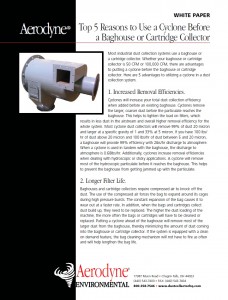A facility in the US that sells microbrewery equipment was having dust issues within its production process. Dust was being produced when ingredients were poured into a tank. While pouring the product from the bag to the tank, a dust cloud was forming and leaving quite a mess behind. The facility was using a bag filter in its process that plant operators would have to manually remove and place back on the tank prior to loading the materials. Not only was the bag filter creating a dust problem, the constant need of removing it and placing it back on the tank was resulting in time lost and money wasted. Looking for a solution the company turned to Aerodyne. After further inquiries about the process, it was decided that they facility would benefit immensely by placing a GPC Dust Collector on the tanks that are loaded. Since the placement of the GPC on to the loading tank, the company’s dust problem has been resolved and the labor that was used to constantly remove the filter bag can now be focused elsewhere at the plant. You can read our new white paper the Top 5 Reasons to Use an Aerodyne Cyclone Before a Baghouse or Cartridge Collector and help improve your processs! Click the photo to learn about the 5 advantages now!
Tom Hobson
Recent Posts
GPC Dust Collector Excels Where Dusty Filter Bag Fails
Aerodyne's Cyclonic Dust Collector Relieves Coal Mine's Pressure Problems
A coal mine in Colorado was experiencing pressurization problems in its conveying line. The facility blows air through the mine shaft with the conveying line that takes the coal out of the mine. The air pressure in the shaft was too high and the mine operators were searching for a way to vent the excess air out. Not only was the air pressure too high, it was also knocking coal dust off of the conveyor, which leads to time spent cleaning it up or fines the company must pay. Irritated with time and money being lost over the air pressure issue, the company reached out to Aerodyne for assistance. After further inquires about the process and limited space available for large equipment, Aerodyne suggested the mine operators use the GPC dust collector. Due to the unique design of this ground plate cyclonic dust collector, it can be installed horizontally and still maintain maximum efficiency.
A welding facility in Virginia recently purchased two Aerodyne GPC Dust Collectors to solve a dusty issue. The welding exhaust leaving the building was causing dust to collect on nearby cars, which was upsetting many of the locals. The GPCs were placed at the end of the exhaust apparatus and the sand sized dust particulates were collected while the clean air was filtered out of the building.
A power plant in Ohio was having problems with over pressurization when feeding limestone into a furnace via pneumatic conveying. The plant operators wanted to put a slip stream with the cyclone at the facility to control the stream. The plant manager recently contacted Aerodyne to see if we could offer some assistance. After further information was gathered, it was concluded that the best solution to the plant's issue would be to attach a Vacu-Valve to its current cyclone. This material handling valve requires no power supply, lubrication, or controls. After months of use, the plant operators are happy with the low-maintenance and cost-effective vacu-valves they have in place at the facility.
Industrial Dust Collection Trade Show After-Thoughts.
A fertilizer manufacturer off the Coast of Madagascar in Mauritius was using cyclones for the dust collection portion of its operation. The cyclones were not operating to the facility’s satisfaction level due to a lack of an air lock on the cyclone’s dust discharge. The company considered using standard airlocks, but due to the corrosive nature of the fertilizer, there was some concern in taking that approach. While researching potential solutions, the company came across the Vacu-Valve® Platypus online and after consultation with Aerodyne purchased a unit for its facility. After the installation of this trickle valve system on its cyclone, the facility noted that the cyclone’s performance improved dramatically. The improvement was so vast, that the manufacturer has chosen to install the Vacu-Valve Platypus on all the cyclones used at the plant.
The Vacu-Valve Proves to be a Cost-Effective Solution to Rotary Valves
Double Dump Valve: A Cost Effective Component of Coffee Production
Coffee production is a great example of an application of a double dump valve, which offers long-lasting dry material handling with minimal wear and air seepage. Once the coffee bean has been harvested, it must be dried and husked. For the wet method, manufacturers use pulping machines to extract the majority of the husk of the bean. Following the fermentation process, hulling machines remove the remainder of the husk and polish the bean. If the coffee bean or husk becomes airborne during the pulping or hulling process, the dust collection system captures the material and discharges it using the double dump valve. This type of valve has tandem gates that work together to collect and dispense coffee bean fragments without compromising the positive or negative pressure in the system. A double dump valve is engineered to handle a variety of dense, abrasive particles without wearing out or becoming jammed like a knife gate or rotary valve. Because of its cost-effective, low-maintenance design, it can save your facility valuable resources over its operational life. Watch our new double dump valve video to learn more about how this valve works.
Aerodyne SplitStream Counter-Cyclonic Dust Collector Solves Problems for Grinding Wheel Manufacturer


